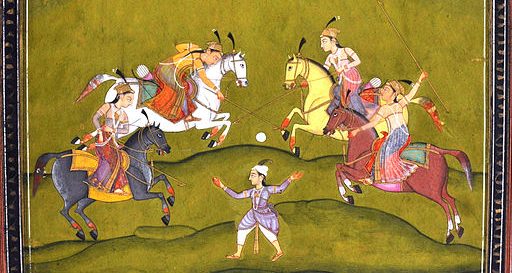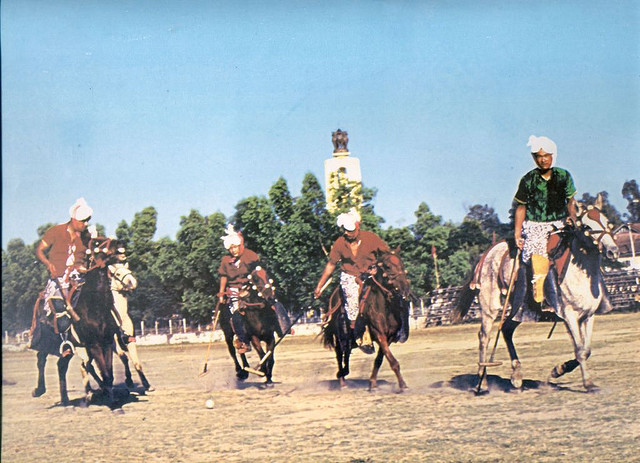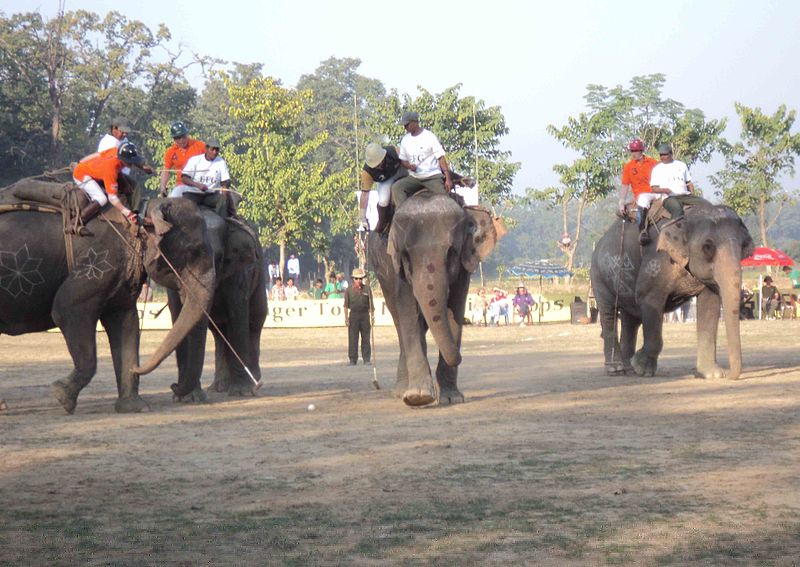The modern game of Polo is played in at least 77 countries including India, Argentina, the USA and the UK. It was even part of the Olympics between 1900 and 1936. But where did it all start?

The very first Polo tournaments were played in Persia or modern-day Iran by tribal nomads. The warlike tribesmen played the game with as many as 100 players to a side. It was a miniature practice battle that was way more brutal than the tame version played today. Later, the game was used to train elite cavalry units, like the king’s guard. In time though, it became a Persian national game, popular with the nobility. Both men and women enjoyed the sport.
Then in the 13th century Muslim conquerors from Persia started making forays into the Indian subcontinent and setting up sultanates. They brought the game with them. When the first Mughal emperor, Babur, also from Persia, set up the Mughal Empire in India in the 15th century, the game became quite famous. Other Indian kings were fascinated by the game and started adopting it as a royal sport. Soon Polo or Chaugan bazi as it was known in those days, became a traditional outdoor game popular in Indian royal families and remained so well into the 18th century. As the years went by, the game evolved and spread to different parts of the country.
By the mid-18th century, the power of the Mughals came to an end and the British East India Company took over. In the 1850s, a group of soldiers from the Company joined some British tea planters, on their travels to Silchar in present-day Assam in North Eastern India. While on their excursion, they came upon a curious sight.

Teams of men, wearing turbans, and shin-guards, were mounted on muscular ponies, riding about, charging at each other, wielding mallets. The centre of all the attention appeared to be a hockey ball! Were these men trying to play hockey on horseback? The British were beyond intrigued. It did look like a lot of fun too.
The men playing the game turned out to be exiled princes from the neighbouring kingdom of Manipur (today an Indian state). The people of Manipur have their own origin story for Polo. Legend has it, that it was the Gods who invented and played the first game of Polo or Sagol Kangjei as it was known there. Iboudhou Marjing, the God of horses is said to have made the first rules of the game. Then apparently in 33 AD deity-king Nongda Pakhangba organised earth’s first polo match.
But whether the game came from the Gods or the tribal nomads of present-day Iran, the British were hooked. They made the game their own and formed the first European polo club in 1859 at Silchar. Soon after, The Calcutta Polo Club was formed in the early 1860s by officers of the British army. It became a popular game amongst the colonists and spread rapidly to England and from there to the world as we know it now. Somewhere along the line some people in present day Nepal, decided to try playing the game using slow elephants instead of swift horses. It was apparently quite a success. This rare alternative is still occasionally played in Nepal, Thailand and the state of Rajasthan in Western India.

Today the World Polo Championship is held every three years by the Federation of International Polo which was formed in 1982 in Argentina. This South American country hosts the world’s most important Polo tournaments. Quite a long way to travel wouldn’t you say from Persia or North Eastern India?
For more such stories join us on one of our trails in Mumbai (to book, write to [email protected] or call +919152021278), Chennai, Pondicherry, Madurai and Trivandrum.
Download the Storytrails App to discover a city all by yourself with our location aware Audio Tours.

Archives
- January 2022
- December 2021
- November 2021
- August 2021
- March 2021
- February 2021
- January 2021
- December 2020
- November 2020
- October 2020
- September 2020
- August 2020
- April 2020
- March 2020
- February 2020
- January 2020
- November 2019
- October 2019
- September 2019
- August 2019
- July 2019
- June 2019
- August 2017
- February 2017
- January 2017
- October 2013
Featured Posts
- Tales that pots tell: Keeladi excavations AUGUST 18, 2021
- The Last Grand Nawab: Wallajah FEBRUARY 10, 2021
- How Tej Singh became Raja Desingu of Gingee FEBRUARY 5, 2021
- How Shahjahan seized the Mughal throne JANUARY 28, 2021
- Alai Darwaza – Qutub Minar Complex, Delhi NOVEMBER 21, 2020
- Marking History through British buildings NOVEMBER 17, 2020
- The last great queen of Travancore NOVEMBER 7, 2020
- Brahmi and the evolution of scripts OCTOBER 15, 2020
- The Cambodian King of Kanchipuram OCTOBER 14, 2020
- James Prinsep – the man who read the writing on the wall OCTOBER 10, 2020
- Mariamman – the Village Goddess who travelled SEPTEMBER 30, 2020
- Misnamed Monuments of Mamallapuram SEPTEMBER 28, 2020








